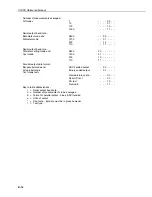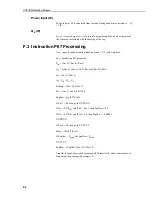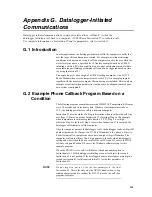
Appendix C. Binary Telecommunications
C-7
Data Type When D,E,F All Equal One
If D, E, and F are all ones, the data type is determined by the other bits as shown
in Table C-1. X implies a ‘don’t care’ condition; i.e. the bit can be either 1 or 0
and is not used in the decode decision.
Table C-1 Low Resolution Data Types
A B C D E F G H
Data Type And Second Byte Format
1
1
1
1
1
1
X X
A,B,C = 1: Start of output array, G & H are the
most significant bits of the output array ID. All
eight bits of the second byte are also included
in the ID.
X X 0
1
1
1
X X
C = 0: First byte of a 4-byte value.
0
0
1
1
1
1
X X
A,B = 0; C = 1: Third byte of a 4-byte value.
0
1
1
1
1
1
1
1
A = 0; remaining bits = 1: First byte of a 2-byte
‘dummy’ word. The CR10X always transmits a
0 for the second byte, but the word can be
decoded on the basis of the first byte only.
C.2.2 High Resolution Format
Continuing to use the A-H bit representation, the 4-byte number is shown as two
2-byte pairs:
AB0111GH
XXXXXXXX
001111GH
XXXXXXXX
Table C-2 Description of High Resolution Format
Bits, first Byte,
1st Pair
Description
CDEF = 0111
Code designating first byte pair of 4-byte number.
B
Polarity, 0 = +, 1 = -.
G,H,A,
Decimal locator as defined below.
Second byte
16th - 9th bit (left to right) of 17-bit binary value.
ABCDEF = 001111
Code designating second byte pair of 4-byte number.
G
Unused bit.
H
17th and MSB of 17-bit binary value.
Second byte
8th - 1st bit (left to right) of 17-bit binary value.
Campbell Scientific defines the largest allowable range of a high resolution
number to be 99999.
Interpretation of the decimal locator for a 4-byte data value is given below. The
decimal equivalent of bits A, G and H is the negative exponent to the base 10.
















































